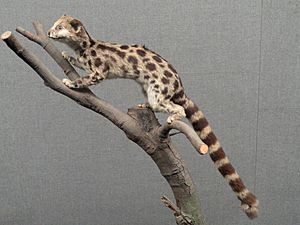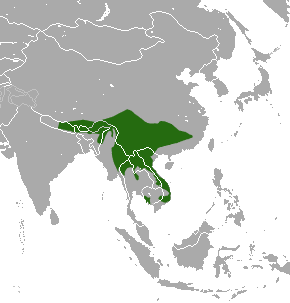Spotted linsang facts for kids
Quick facts for kids Spotted linsangTemporal range: Middle Miocene-Present
|
|
|---|---|
 |
|
| Conservation status | |
| Scientific classification | |
| Genus: |
Prionodon
|
| Species: |
pardicolor
|
 |
|
| Spotted linsang range | |
The spotted linsang (Prionodon pardicolor) is a cool animal from Southeast Asia. It's a type of Asiatic linsang, which means it's a small, tree-dwelling carnivorous mammal. This animal is found in many places, but it's often hard to spot. Scientists say it's currently doing okay, so it's listed as Least Concern on the IUCN Red List.
Contents
What Does a Spotted Linsang Look Like?
The spotted linsang looks a lot like its cousin, the banded linsang. It has a long, thin body and short legs. Its neck and head are also long, and it has a long tail.
Fur Color and Markings
The color of its fur can be different shades. It might be a dark brown or a light, creamy yellow. It has two long stripes that start behind its ears. These stripes go all the way to its shoulders or even further. There are also two shorter stripes on its neck.
On its back, you'll see three or four rows of spots. These spots get smaller as they go down towards its belly. Its front legs have spots all the way to its paws. The back legs have spots up to the hock, which is like its ankle. Its tail is round and has eight or nine wide dark rings. These dark rings are separated by thin white rings.
Paws and Claws
The spotted linsang has five toes on each foot. The area between its paw pads is covered with fur. Its claws can pull back, just like a cat's claws. Its front paws have special skin pockets that cover the claws. The back paws have protective skin flaps instead.
Size and Weight
This animal is quite small. It weighs about 1 lb (0.45 kg). Its body length is about 14–15 in (360–380 mm). Its tail adds another 12–13 in (30–33 cm) to its length. The linsang stands about 5–5.5 in (13–14 cm) tall. Its chest is about 5.75 in (14.6 cm) around. The length of its head to the back of its skull is about 3 in (7.6 cm).
Where Do Spotted Linsangs Live?
Spotted linsangs live across a wide area in Asia. You can find them in eastern Nepal and parts of India, like Sikkim, Assam, and Bengal. They also live in Bhutan, northeastern Myanmar, northern Thailand, Laos, and northern Vietnam. In China, they are found in western Sichuan, Yunnan, Guizhou, and southwestern Guangxi.
Habitat and Protection
Even though they live in many places, it's rare to see them. They are not common anywhere in their range. In northern Bengal, they are seen very rarely.
Spotted linsangs mostly live in evergreen forests and areas with lots of shrubs. A big part of these habitats is not protected. This means that these animals might be in danger. Their homes could be lost due to habitat loss.
In a place called Nam Et-Phou Louey National Biodiversity Conservation Area, a spotted linsang was seen in 2017. It was in an area where banana plants were growing after the original forest was cleared.
How Do Spotted Linsangs Live?
The spotted linsang is a nocturnal animal. This means it is active mostly at night. It likes to be alone and lives by itself. It also spends at least some of its time in trees, making it partly arboreal.
Resting and Hunting
These animals use hollows inside trees to rest and make their dens. They hunt for food both on the ground and up in the trees. Their diet includes small animals like rodents, frogs, and snakes. They have also been seen eating dead animals they find.
Interesting Facts About Spotted Linsang Family
The Asiatic linsangs, including the spotted linsang, belong to a group called Prionodon. For a long time, people thought they were part of the Viverridae family. This family includes other animals like civets and genets. It also includes the African linsangs.
A New Family Tree
However, scientists have learned new things. In 2004, studies of their genes showed something different. The Asiatic linsangs are actually not closely related to the Viverridae family at all. Instead, they might be the closest living relatives to the Felidae family, which is the cat family!
Because of this, Asiatic linsangs have been placed in their very own family. This new family is called Prionodontidae. The similarities between the Asiatic and African linsangs are just a coincidence. They look alike because they adapted to similar ways of life, not because they are closely related.


